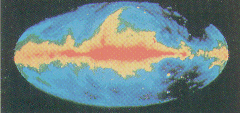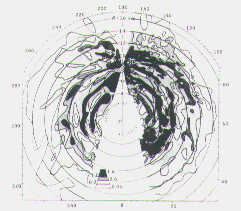

Large telescopes, like the Lovell Telescope, are invaluable in making surveys of the sky.The picture shows a map of the whole sky made by three of the world's largest telescopes; the 100-metre near Bonn, the 64-metre near Parkes in Australia, and the Lovell Telescope.Made at a wavelength of 73 centimetres, the map shows mainly "continuum" radiation emitted by electrons spiralling in the magnetic field of the Galaxy.It is colour-coded so that the brightest areas appear red and the faintest violet and black. The bright band of the Milky Way dominates the picture, but otherwise the radio sky bears no resemblance to the dark,starry sky we see at visual wavelengths.

Another kind of radiation is "line" emission,radiated at precise frequencies by atoms and molecules.Line emission tells us much about the chemical composition and physical conditions of astronomical objects. The most important radio astronomical line is the 21-centimetre emission from hydrogen atoms,which make up the bulk of the gas lying between the stars. It has proven to be a most powerful probe of the structure of our Galaxy, as can be seen in this picture of the galactic spiral arms, mapped out by observations of the hydrogen line.
Among the strangest objects in the Galaxy are the pulsars, first discovered by radio astronomers at Cambridge in 1967. Pulsars are neutron stars, collapsed remnants of much bigger stars that have exploded as supernovae. They spin on their axes many times a second, emitting regular pulses of radio waves much like cosmic lighthouses. Over 500 pulsars are now known,mainly confined to the plane of the Milky Way with a concentration towards the centre of our Galaxy.
Large telescopes are essential for pulsar work, and Jodrell Bank is now the leading European centre for pulsar observations. Astronomers at Jodrell Bank discovered that pulsars are ejected from their place of origin in the galactic plane at speeds of hundreds of kilometres a second. More recently they discovered several "millisecond" pulsars rotating hundreds of times a second in the cores of globular clusters - compact swarms of up to a million stars.
